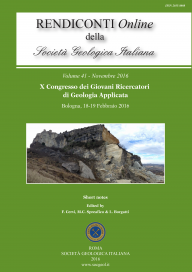
The Sant'Andrea-Molinello landslide system (Mt. Pruno, Roscigno, Italy)
Mario Valiante (a), Francesca Bozzano (b) & Domenico Guida (c)
(a) E-mail: mario.valiante@gmail.com
(b) Department of Earth Science & CERI, Sapienza University of Rome, Italy.
(c) Department of Civil Engineering, University of Salerno, Italy.
Volume: 41/2016
Pages: 214-217
Abstract
This paper illustrates the landslide processes that affect the southern hillslope of Mt. Pruno in the Sant'Andrea-Molinello area close to Roscigno village (Cilento, Vallo di Diano and Alburni Geopark, Campania region, Italy). The area involved by the slope instability is about 0,7-1 km2 extended and it includes the provincial road no. 342 between the Roscigno and Corleto Monforte villages and other rural roads and farms. The landslide occurred and evolved during the first week of December 2010, as a consequence of the intense rainfalls fallen during the previous month. A detailed field survey highlighted that the 2010 event was only a partial reactivation of a larger landslide system with a very complex structure and long-term evolution.
Peculiar geological and hydrogeological conditions control the general instability. The structural setting of the slope is made by the tectonic overlapping of two different structurally complex formations: the Torrente Trenico Marls and Calcarenites Fm. (B1/B2 class), constituting the local upper aquifer, over the Argille Varicolori Superiori Fm. (B2/B3 class), sheared marly clays, as basal aquitard. The primary gravitational event, classified as multiple rock block slide, was probably induced by rapid, local relief creation during the Late Pleistocene, following the downstream Sammaro River's gorge incision. During Holocene and historical times, secondary landslide phenomena, triggered by an increased water pressure within perched layers, affected and progressively disarticulated the primary one by rock slide complexes evolving in complex earth slide-flows.
Based on the above geomorphological model and original geotechnical data, stability analyses were carried out in the northern portion of the landslide area. The safety factors, evaluated under different recharge conditions and the sensitivity analysis to pore water pressure confirm the hypothesis of rainfall-induced, partial reactivation with an about 50-years return time.
Keywords
Get Full Text